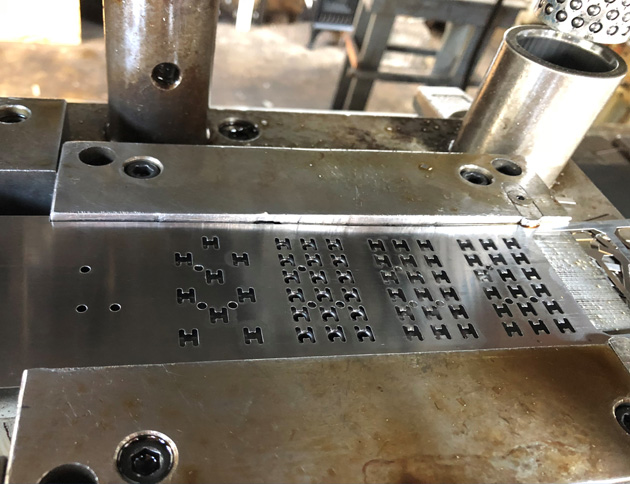The Advancement of Metal Marking Procedures: Advancements and Applications
The world of metal stamping procedures has actually observed a transformative journey noted by consistent innovation and adjustment to meet the needs of contemporary commercial methods. From the conventional approaches deeply rooted in background to the sophisticated technologies driving high-speed accuracy, the advancement of steel marking has actually been absolutely nothing except amazing. As new tooling methods and automation locate their means right into this sector, the effects for performance and quality are extensive. The applications cover throughout a range of markets, each profiting distinctly from the developments in metal marking procedures.
Standard Metal Stamping Techniques
Standard steel stamping strategies have actually long been the structure of manufacturing procedures in different industries due to their performance and accuracy. The process includes developing a metal sheet or coil right into a desired form by pushing it between a die and a punch. This method is widely utilized for producing big quantities of get rid of high precision at a quick speed.
One of the crucial benefits of conventional metal stamping methods is the ability to keep tight tolerances, making sure that each part satisfies the called for specifications continually. This degree of precision is vital in sectors such as automotive, aerospace, and electronics, where even minor discrepancies can result in considerable issues.
Moreover, traditional metal marking strategies provide cost-effective solutions for mass manufacturing compared to various other making methods. The ability to stamp components in quick succession lessens manufacturing time and decreases labor costs, making it an eye-catching choice for organizations wanting to maximize their manufacturing procedures.
Introduction of High-Speed Stamping

Among the key advantages of high-speed marking is its capacity to preserve accuracy and consistency also at accelerated handling rates. This precision is important in industries where limited resistances and elaborate layouts are required. In addition, high-speed stamping enables the processing of a variety of products, consisting of aluminum, stainless-steel, and copper, more expanding its applicability throughout numerous industries.
In addition, the emergence of high-speed stamping has actually made it possible for producers to satisfy the expanding demand for complicated parts in sectors such as automotive, aerospace, and electronics (Metal Stamping). By leveraging the rate and precision of high-speed marking modern technology, companies can improve their competition in a swiftly evolving market landscape
Developments in Tooling Innovation
With the advancement of high-speed marking enabling improved precision and effectiveness in steel creating procedures, the area of steel marking has seen significant developments in tooling innovation. Tooling innovation plays a critical duty in steel stamping procedures, influencing aspects such as item high quality, production speed, and overall cost-effectiveness. One essential innovation in tooling technology is the development of smart tooling systems that include sensing units and checking tools to supply real-time information on the stamping procedure. These systems can find issues such as tool wear or misalignment, enabling immediate modifications to preserve optimal performance.
Additionally, advancements in products scientific research have actually resulted in the creation of tooling products with enhanced durability, put on resistance, and thermal conductivity. By using these innovative products, tooling producers can generate dies and mold and mildews that stand up to the high pressures and temperature levels involved in steel stamping procedures, leading to longer device life and enhanced manufacturing effectiveness. In addition, developments in device layout, such as using simulation software and additive production techniques, have made it possible for the development of intricate tooling geometries that were previously testing to produce. Generally, these advancements in tooling innovation have actually transformed the steel marking industry, enabling suppliers to accomplish greater degrees of precision, efficiency, and price savings.
Combination of Automation in Stamping
As automation remains to reshape the landscape of metal stamping processes, the combination of automated systems has ended up being progressively common in contemporary production centers. Automated systems use many advantages in metal stamping, including increased efficiency, improved accuracy, and enhanced safety and security. By including automation right into marking processes, producers can decrease cycle times, reduce material waste, and optimize manufacturing throughput.
Among the crucial components of automation in marking is the usage of robotic arms for jobs such as material handling, part adjustment, and high quality inspection (Metal Stamping). These robot systems can carry out repetitive and labor-intensive jobs with rate and precision, maximizing human operators to concentrate on even more complex procedures. Additionally, automation enables real-time surveillance and modification of marking processes, leading to greater overall procedure control and quality control
Furthermore, the assimilation of automation in stamping makes it possible for producers to attain consistent component quality, satisfy tight resistances, and enhance general performance. As innovation remains to advancement, the function of automation in steel stamping image source procedures is anticipated to expand additionally, driving innovation and effectiveness in the production industry.
Applications Across Diverse Industries
Integrating steel stamping processes throughout varied industries showcases the adaptability and flexibility of this manufacturing method. From automotive to aerospace, electronics to medical tools, steel stamping plays a vital duty in the production of a broad array of components. In the automobile market, steel marking is made use of to create elaborate parts such as body panels, chassis parts, and engine components with high accuracy and performance. The aerospace sector depends on metal stamping for producing lightweight yet long lasting elements for aircraft and spacecraft. In the electronics market, metal stamping is vital for creating connectors, get in touches with, and various other little check this site out components with limited tolerances. Clinical tool makers make use of metal marking for developing precise components like surgical instruments and implants. Furthermore, the appliance market advantages from metal stamping procedures to manufacture components for fridges, washing equipments, and various other house devices. The flexibility of steel stamping processes makes it a valuable manufacturing technique across various sectors, showing its value in contemporary production procedures.
Final Thought

Comments on “Metal Stamping Procedures: From Prototyping to Automation”